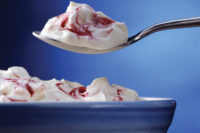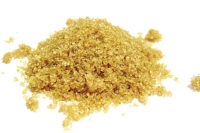

The Healthy People 2010 objectives aim for at least 75% of Americans to eat the recommended two or more daily servings of fruit, and for at least 50% of Americans to eat the recommended three or more servings of vegetables daily. However, this survey by CDC indicates that only 33% of adults meet the recommendation for fruit consumption and 27% get the recommended servings of vegetables. The statistics are even worse for high school students: 32% report eating at least two servings of fruit daily and 13% say they eat at least three servings of vegetables each day.
“A diet high in fruits and vegetables is important for optimal child growth, maintaining a healthy weight and prevention of chronic diseases such as diabetes, heart disease and some cancers, all of which currently contribute to health care costs in the United States,” says William Dietz, director of CDCs Division of Nutrition, Physical Activity and Obesity.
To view the full report, visit:http://www.fruitsandveggiesmatter.gov/indicatorreport/.
The fact is that most consumers know the importance of a diet that includes a colorful variety of fruits and vegetables and the resulting benefits on overall health. The challenge is to consume the recommended daily dose. All fruit forms count, and savvy dairy foods formulators are choosing high-fruit content ingredients rather than diluted fruit ingredients or simply fruit flavors in order to make a fruit content per serving declaration.
In the spirit of the season, here is some motivating information to have you consider formulating with cranberries. Recent research confirms that the crimson berry may be small, but its health benefits are large. Leading scientists from throughout the country and abroad convened on October 28 in Savannah, Ga., for the Fourth Cranberry Institute Health Research Conference to review the latest findings on the potential health benefits of cranberries.
More than 30 nutrition scientists from leading research institutions, including the National Institutes of Health, the U.S. Department of Agriculture and a variety of prestigious universities, presented new findings about the cranberry’s antibacterial and anti-adhesion properties, as well as promising new areas of research in anti-aging, anti-cancer and protection against cardiovascular disease, metabolic syndrome and type II diabetes.
“New studies are continually finding how unique cranberries are, and that their potential health benefits are impressive,” says Jere Downing, executive director, Cranberry Institute, East Wareham, Mass., the nonprofit organization dedicated to cranberry health research.
There seems to be no denying that cranberries are antioxidant-rich and deliver unique proanthocyanidins (PACs) that are responsible for cranberries’ beneficial anti-adhesion properties. Cranberries may offer help to more than 11 million American women each year who contract urinary tract infections (UTIs). UTIs cost some $1.6 billion in healthcare and the only known treatment is antibiotic therapy, which increasingly contributes to creating bacterial resistant strains of pathogens.
Cranberry PACs have been shown to protect against P-fimbriatedEscherichia coli, which is thought to be responsible for as much as 95% of UTIs, and other strains ofE. coli bacteria through anti-adhesion properties, so that pathogenic bacteria are unable to adhere to cells, multiply and cause an infection. The same anti-adhesion benefits studied in urinary tract health are now being identified in other areas of the body, such as the oral cavity, stomach and small intestine. Studies at the conference identified that cranberry PACs help prevent oral bacteria from adhering to tooth and denture surfaces, thereby helping to protect against gum disease and cavities. While more studies are needed, the preliminary studies suggest that cranberry PACs may play a role in oral health, gastrointestinal health and protection against bacterial, fungal and even viral illnesses.
Other berries have been making headlines, too. According to a new study published in the October 2009 issue ofNutrition Journal, women with metabolic syndrome had reduced total cholesterol levels - including low-density lipoprotein (LDL, or “bad” cholesterol) - after a brief period of daily consumption of a strawberry-based beverage. This news came on the heels of other research that showed antioxidant levels in strawberries can improve and maintain the effectiveness of cholesterol-lowering diets. Both of these recent studies concluded that the cholesterol-lowering effects may be attributed to one or more of the following: antioxidants, fiber or phytochemicals in strawberries.
Blueberries are powerful, too. “We’ve seen a positive effect of blueberries on brain function and are encouraged by this new research that shows a positive link to heart health,” says James Joseph from the USDA Human Nutrition Research Center on Aging at Tufts University, Boston.
“We’re finding that what’s good for the brain is also good for the heart,” adds Don Ingram from Louisiana State University’s Pennington Biomedical Research Center, Baton Rouge, La. “In this study blueberries appear to act as both an antioxidant and anti-inflammatory agent providing a protective effect against cardiovascular damage.”
Mary Ann Lila from North Carolina State University, Plants for Human Health Institute, Kannapolis, N.C., led a team of researchers that demonstrated that blueberry phytochemicals helped alleviate hyperglycemia in rodent models, a condition associated with diabetes and metabolic syndrome. “Anthocyanins, the natural plant compounds that give wild blueberries their deep blue color, may have anti-diabetic activity,” Lila says. “With metabolic syndrome and diabetes on the rise, gaining a better understanding of how a healthy diet rich in fruits and vegetables may forestall some of these conditions is critical.”
Overall, these types of studies continue to demonstrate a valid scientific reason for formulating dairy foods with fruit, in particular berries. This Berry believes in the power of berries.

